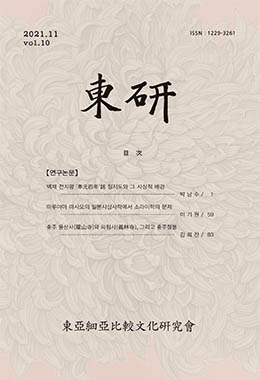필자는 칠지도 연구의 가장 첨예한 쟁점이 되는 연호와 제작일을 길상구설의 문제와 함께 살피고자 하였다. 특히 본 명문의 연호를 ‘奉元’으로 석독하고, 본 칠지도를 전지왕 4년(408) 11월 16일에 제작하였음을 확인하였다. 또한 본 명문의 주요 쟁점 가운데 ‘丙午 正陽’ 및 ‘奇生’의 의미를 살피고, 칠지도가 『周易』의 ‘奇生’의 원리에 바탕하여 양의 기운이 생성하는 동짓날을 택하여 제작된 것이었음을 확인할 수 있었다. 이에 동 명문상의 ‘마땅히 후왕에게 준다(冝供供侯王)’거나 ‘백제 왕세자가 倭王을 위하여 旨를 내려 만들었으니 후세에 전하여 보이라(爲倭王旨造傳示世)’고 한 것은, 괘상에서 乾과 坎의 강건함은 백제이고, 坤과 离의 유순함은 왜를 지칭한 것을 반영한 것으로 보았다. 나아가 명문 ‘百練銕七支刀’의 ‘七支’가 불교의 전륜성왕 칠보 가운데 象寶의 특징을 묘사한 것이라는 점에서, 칠지도 제작에 있어서 전륜성왕 이념의 투영 가능성을 상정하였다.
I tried to elucidate the prodcution date and the equivalent era name of the Seven-branched Sword (K. Chiljido) with the issue of an auspicious sign theory. In particular, it was confirmed that the era name indicated in the inscription engraved on Chiljido as ‘Bong-won (Ch. 奉元),’ and that this sword was produced on November 16, the 4th year of King Jeonji's reign (408). In addition, the meaning of '丙午 正陽' and '奇生' among the main issues related to the inscription was examined. Through this process, it was figured that Chiljido was produced on the winter solstice day when the energy of Yang (Ch. 陽) was generated based on the principle of ‘奇生’ from the Book of Changes.
Therefore, it analyzed the meaning of 'giving it to a feudal lord(Ch. 冝供供侯王) ' or 'the crown prince of Paekche issued an edict to make the sword for the king of Japan, so give it to future generations.' The meaning seems to reflect that the robustness of trigrams of the sky (Ch. 乾) and water (Ch. 坎) in the trigrams from the Book of Changes is Paekche, and the meekness of trigrams of the earth (Ch. 乾) and fire (Ch. 离) refers to Japan. Furthermore, given that ‘seven branches (Ch. 七支)’ included in the phrase ‘Seven-branched Sword of 100 times tempered iron (Ch. 百練銕七支刀)’ describes the characteristics of ‘the Jewell of Elephant’ among the Seven Treasures of Chakravarti of Buddhism, the possibility of projecting the ideology of Chakravarti in the production of Chiljido was assumed.


